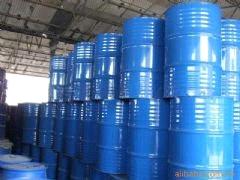Hexane
| Infobox on Hexane | |
|---|---|
| Example of Hexane |  |
| Facts | |
| Origin | - |
| Stowage factor (in m3/t) | - |
| Humidity / moisture | - |
| Ventilation | - |
| Risk factors | See text |
Hexane
Description
Hexane is a hydrocarbon with the chemical formula C6H14; that is, an alkane with six carbon atoms.
The term may refer to any of four other structural isomers with that formula, or to a mixture of them. In the IUPAC nomenclature, however, hexane is the unbranched isomer (n-hexane); the other four structures are named as methylated derivatives of pentane and butane. IUPAC also uses the term as the root of many compounds with a linear six-carbon backbone, such as 2-methylhexane C7H16, which is also called "isoheptane".
Hexanes are significant constituents of gasoline. They are all colourless liquids at room temperature, with boiling points between 50 and 70°C, with gasoline-like odour. They are widely used as cheap, relatively safe, largely unreactive, and easily evaporated non-polar solvents.
In industry, hexanes are used in the formulation of glues for shoes, leather products, and roofing. They are also used to extract cooking oils from seeds, for cleansing and degreasing all sorts of items, and in textile manufacturing.
A typical laboratory use of hexanes is to extract oil and grease contaminants from water and soil for analysis. Since hexane cannot be easily deprotonated, it is used in the laboratory for reactions that involve very strong bases, such as the preparation of organolithiums, e.g Butyllithiums are typically supplied as a hexane solution.
In many applications (especially pharmaceutical), the use of n-hexane is being phased out due to its long term toxicity, and often replaced by n-heptane, which will not form the toxic (hexane-2,5-dione) metabolite.
Hexanes are chiefly obtained by the refining of Crude Oil. The exact composition of the fraction depends largely on the source of the oil (crude or reformed) and the constraints of the refining. The industrial product (usually around 50% by weight of the straight-chain isomer) is the fraction boiling at 65–70°C.
Chemical identity
n-Hexane is a very volatile aliphatic hydrocarbon. It is a constituent in the paraffin fraction of crude oil and natural gas and is also used as an industrial chemical and laboratory reagent. Laboratory grade
n-hexane contains approximately 99% n-hexane. “Hexane” or “hexanes” is a commercial and industrial product consisting of a mixture of hydrocarbons with six carbon atoms and includes n-hexane and its isomers 2-methylpentane and 3-methylpentane as well as small amounts of other hydrocarbons. Laboratory and industrial solvents such as “hexane” and petroleum ether contain n-hexanefrom <0.1% to as much as 33%. Many commercial grades of n-hexane contain appreciable amounts of other hydrocarbons in addition to n-hexane (for instance, toluene or such solvents as acetone or methyl ethyl ketone; see below for other chemicals in such mixtures). Various types of commercial grades of n-hexane are available, and the constituents besides n-hexane are usually an intentional part of the process for preparing these commercial mixtures. Where intended for specialized oil extraction or laboratory uses, the purity of the n-hexane products may be in the range of 95-99% n-hexane; for a variety of uses where purity is not as important, commercial n-hexane mixtures (in the range of 20-80% of n-hexane) may contain small amounts of chemicals such as acetone, methyl ethyl ketone, dichloromethane, and trichloroethylene, aromatics such as toluene, and other types of petroleum hydrocarbons. In commercial grades of n-hexane, some of the constituents are purposefully added as denaturants, often to discourage the abuse of the chemical to induce “highs” through sniffing or inhalation.
Physical and chemical properties
The National Fire Protection Association (NFPA) has assigned n-hexane a health hazard identification code of 1 (slight) and flammability code of 3 (serious) (NFPA 1994). n-Hexane is flammable and may be ignited by heat, sparks, and flames. Flammable vapour may spread away from a spill. The vapour may be an explosion hazard. n-Hexane can react vigorously with oxidizing materials such as liquid chlorine, concentrated oxygen, and sodium hypochlorite. n-Hexane will attack some forms of plastics, rubber, and coatings.
Application
Solvent, especially for vegetable oils, low temperature thermometers, calibrations, polymerization reaction medium, paint dilutent, alcohol denaturant.
Hexane is used to extract oil from grains as well as protein from soy. Hexane can persist in the final food product created; in a sample of processed soy, the oil contained 10 ppm, the meal 21 ppm and the grits 14 ppm hexane. The adverse health effects seem specific to n-hexane; they are much reduced or absent for other isomers. Therefore, the food oil extraction industry, which relied heavily on hexane, has been considering switching to other solvents, including isohexane (2-methylpentane).
Shipment / Storage
Usually in drums.
Risk factors
Flammable, dangerous fire risk. TLV: 50 ppm in air.
Consult the IMDG Code and applicable MSDS sheet for overseas transport.
See also: http://www.chemicalland21.com/petrochemical/n-HEXANE.htm











